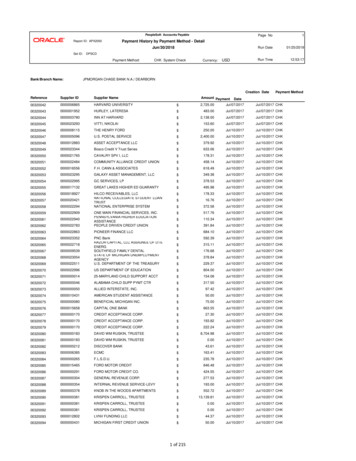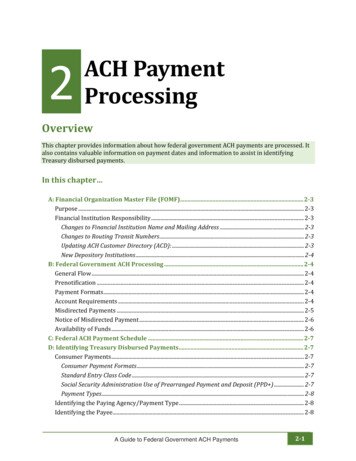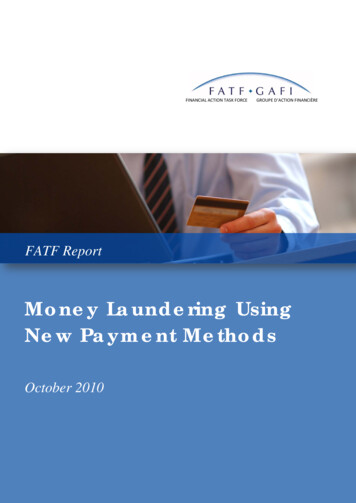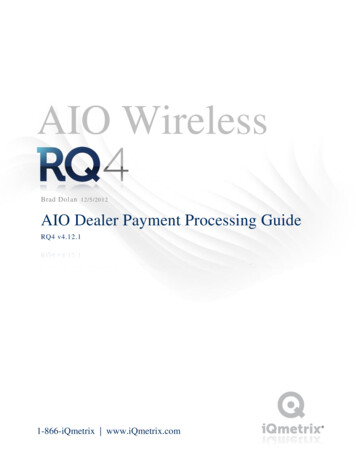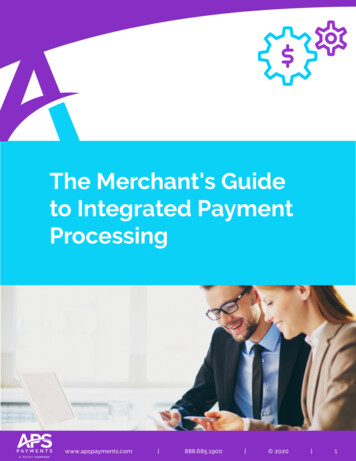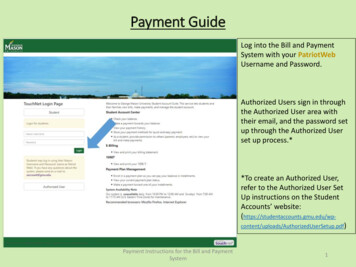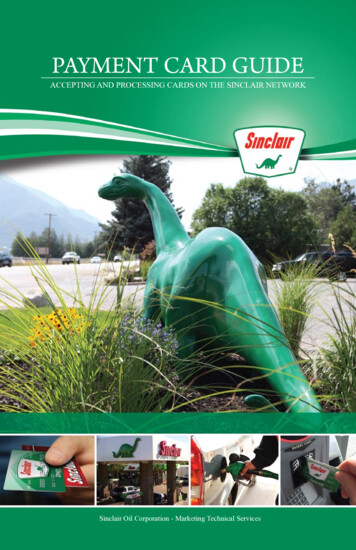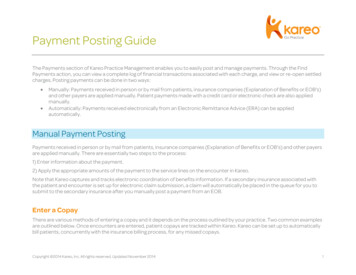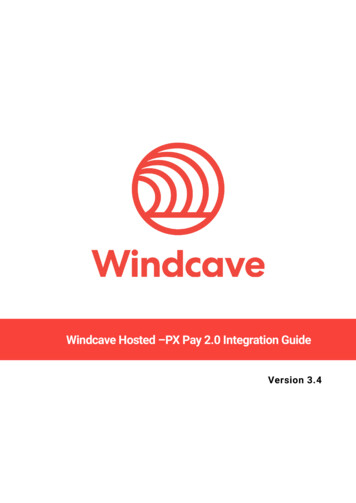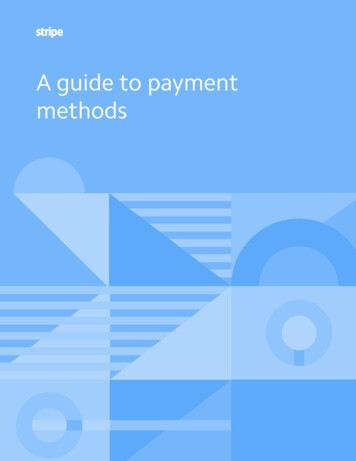
Transcription
A guide to paymentmethods
IntroductionAs online tools make it easier to connect with global customers, more and more businessesare selling overseas. In fact, a Stripe study found that 70% of online businesses are sellinginternationally today. While it’s easier than ever to reach a global audience, online businesses arealso faced with a new challenge: How do you address the diverse customer preferences of a globalaudience during the checkout experience? The way customers prefer to pay for goods or servicesonline varies drastically based on where they are located. If you don’t create a relevant, familiarpayment experience, you could cut off entire countries from your addressable market.While the global payments landscape has become increasingly complex and fragmented, Stripemakes it easy for any type of business anywhere in the world to discover and accept popularpayment methods with a single integration.This guide helps you evaluate and identify the payment methods that are well-suited to yourbusiness model and customer preferences and offers an in-depth look at the payment methodsStripe supports.The benefits of payment methodsOver the past decade, payment methods have evolved to support different consumer andbusiness needs. Markets with high card penetration, such as the US and the UK, have seen asignificant shift towards digital wallets like Apple Pay and Google Pay, which offer more securityand convenience. Some markets, such as France and Japan, even have their own local cardnetworks that help businesses reach more card users. In markets like Germany and Malaysia,where card use is much lower, bank-based methods are strongly preferred and trusted for onlinepurchases. The banking networks in these markets typically offer a faster and more securecheckout experience where users can authorize a payment using their online banking credentials.Meanwhile, in economies with a large unbanked population, such as Mexico and Indonesia, popularCards, Digital Wallets, Bank Debits and Transfers, Cash-Based, Otherpayment methods allow customers to pay for online goods with cash using vouchers.UNITED IGITAL WALLETS5%BANK DEBITS ANDTRANSFERS6%29%47%CASH-BASEDOTHER16%15%These graphs show how payment method preferences vary across countriesA guide to payment methods2
By accepting payment methods that are both preferred by your customers and relevant for yourbusiness model, you can: Reach more customers globally: As you expand into new regions, accepting local paymentmethods may be necessary to capture the total market opportunity. For example, 54%of online transactions in China involve digital wallets such as Alipay or WeChat Pay, and20% with the local card network China Union Pay. Without supporting these paymentmethods, you may risk missing out on the substantial and growing buying power of Chineseconsumers. Increase conversion: Up to 16% of shoppers abandon their cart if their preferred paymentoption isn’t available. Surfacing the right mix of payment options to customers canmeaningfully increase the chances that they’ll successfully complete a purchase. Reduce fraud and disputes: Anticipate and manage the risks associated with acceptingonline payments by choosing payment methods that match your risk preferences. As ageneral rule, the better the level of customer authentication, the lower the likelihood offraudulent and disputed payments. Optimize your transaction costs: Payment methods have inherently different coststructures. Depending on your business model, where your customers are located, and youraverage transaction value, you may be able to reduce your fees by accepting lower-costpayment methods like bank debits.Choosing the right payment methods for your businessWhether you want to improve conversion in your domestic market or expand globally, surfacingrelevant payment methods to your customers is key. Depending on your business model andwhere your customers are located, certain payment methods may or may not be relevant.This section covers the seven major payment method families and specific considerationsbased on your business model: e-commerce and marketplaces, on-demand services, SaaS andsubscription businesses, or professional services. If you are a B2B platform that enables yourusers to accept payments, your relevant payment methods depend on the business model of yourusers (for example, if your users have a SaaS business model, refer to the “SaaS and subscriptionbusinesses” section).A guide to payment methods3
SSUPPORTSDISPUTESPAYMENTCONFIRMATIONCardsCards are linked to a debit or creditaccount at a bank. To complete apayment online, customers entertheir card information at tal walletsDigital wallets are linked to acard or bank account, but canalso store monetary value. Digitalwallets typically require customerverification (e.g., biometrics, SMS,passcode) to complete a payment.YesYesYes, lowerdisputerate thancardsImmediateBank debitsBank debits pull funds directlyfrom your customer’s bankaccount. Customers provide theirbank account information andtypically agree to a mandate foryou to debit their account.YesYesYes, lowestdisputerateDelayedAuthenticatedbank debitsAuthenticated bank debit methodsadd a layer of verification tocomplete a bank debit payment.Instead of entering their bankaccount information, customersare redirected to provide theironline banking credentials toauthorize the payment.No, but Stripesupportsrecurring forsomemethods byconverting todirect debitYesNoImmediateBank credittransfersCredit transfers allow customersto push funds from their bankaccount to yours. You providecustomers with the bank accountinformation they should sendfunds to.NoYesNoDelayedBuy now,pay laterBuy now, pay later is a growingcategory of payment methodsthat offers customers immediatefinancing for online payments,typically repaid in fixedinstallments over time.NoYesYes, mostmethodswill takeon fraudriskDelayedCash-basedpaymentmethodsWith cash-based paymentmethods, customers receivea scannable voucher with atransaction reference numberthat they can then bring to anATM, bank, convenience store,or supermarket to complete thepayment in cash.NoNoNoDelayedA guide to payment methods4
For e-commerce and marketplacesRecommended: Cards, digital wallets, authenticated bank debits, “buy now, pay later”While frictionless checkout experiences are vital for any business model, its importanceis magnified for e-commerce and marketplaces. Customers expect streamlined paymentexperiences—ones that give them what they want, when they want it. The right set of paymentmethods not only offers payment flexibility and convenience to maximize conversion, but alsoreduces fraud and increases transaction speed.Cards are the most commonly used payment method and it’s important that you supportall relevant card brands to optimize conversion and costs. Digital wallets and authenticatedbank debits can also help increase conversion by allowing customers to use stored paymentinformation (the added verification also lowers the possibility of disputes). Digital wallets, likecards, are a reusable payment method—customers provide their payment details once and if thatinformation is stored, they don’t need to share any additional information for future payments.This enables you to offer one-click checkout experiences. If you sell high-value goods, consider“buy now, pay later” payment options, which allow your customers to customize their paymentterms and break up purchases into smaller installments.In many large markets with low card use, such as Brazil, Mexico, and Indonesia, customersprefer to pay with cash-based payment methods and bank credit transfers, which don’t supportimmediate payment confirmation or native refunds. This can create challenges for e-commercebusinesses that typically rely on real-time payment notifications to manage their shipping flows orrefunds to promote customer loyalty. Stripe can help global businesses cater to these customersby enabling automated refund experiences and faster notifications for payment types that don’ttypically support these features.For on-demand servicesRecommended: Cards, digital walletsWith instant fulfillment at the heart of the customer experience, on-demand services needto encourage conversion—often on mobile—while managing fraud risk. Consider focusing onpayment methods that offer immediate confirmation that the transaction was successful, suchas cards and digital wallets. These payment options also allow you to store customer paymentdetails on file and enable one-tap confirmations, shortening the checkout experience. Whiledigital wallets typically have the same transaction cost as cards, they are more secure sinceauthentication is required to complete payment, lowering fraud and dispute rates.It’s still important to consider the local context as payment methods with more friction may betrusted and preferred to pay for on-demand services or add top-ups to customers’ app balance.A guide to payment methods5
For SaaS and subscription businessesRecommended: Cards, digital wallets, bank debitsIf you manage recurring revenue and want to optimize your checkout experience for ongoingtransactions, it’s important to consider whether or not payment details can be stored on file andreused. The ability to reuse a customer’s payment credentials allows you to initiate paymentson a custom schedule, without requiring any action by your customers. Cards, digital wallet, andbank debit payments are all reusable—customers only need to provide their card number orbank account details once. And, for customers who prefer to use authenticated bank debits suchas iDEAL, SOFORT, or Bancontact, Stripe makes it possible to use these methods for recurringpayments by converting them into direct debits.In addition, many SaaS and subscription companies face involuntary churn issues, wherecustomers intend to pay for a product but their payment attempt fails due to expired cards,insufficient funds, or incorrect card details. In fact, 9% of subscription invoices fail on the firstcharge attempt due to involuntary churn. Stripe Billing can help manage recurring declines forcards, in addition to supporting many of the most relevant payment methods for increasingrecurring payment conversion (for example, because bank account information doesn’t expire,accepting bank debits can increase retention).While accepting reusable payment methods is beneficial to the business, it’s also important toconsider local expectations regarding recurring billing. For example, in markets like Brazil andIndonesia, it’s common to send recurring invoices or reminders for customers to initiate eachpayment. Stripe Billing makes it easy to accommodate both recurring charges and invoicing.For professional servicesRecommended: Cards, bank debits, bank credit transfersIf you offer professional services or wholesale products, even a single payment failure or disputecould result in significant revenue loss. The ability to securely and successfully accept largepayments can protect your business and can be solved, in part, by invoicing your customers sothey have more flexibility to initiate payment when funds are available. Historically this has oftenmeant asking customers to send checks. You can also send a hosted invoice with built-in supportfor cards and bank methods to minimize payment failure and automate payment tracking andreconciliation.In addition, bank credit transfers are a secure, non-disputable payment option that is oftenpreferred for very large payments. Credit transfer funds are deposited directly into your accountonce the payment has been confirmed. Credit transfers also require your customers to initiatethe payment, adding an extra level of authentication and security. And, because contracts aretypically in place before payment, it’s less important that your business initiates the payment andA guide to payment methods6
more important that payments don’t fail and can’t be disputed. While tracking and reconciliationfor credit transfers can be difficult, Stripe generates virtual bank account numbers to keepyour company’s banking details private and automatically reconcile incoming payments withoutstanding invoices.E-COMMERCE ANDMARKETPLACESGlobalcustomersAsia PacificcustomersON-DEMAND SERVICESSAAS AND SUBSCRIPTIONPROFESSIONALSERVICESAmerican ExpressAmerican ExpressAmerican ExpressAmerican ExpressDiscover and DinersDiscover and DinersDiscover and DinersDiscover and VisaVisaVisaClick to PayClick to PayClick to PayApple PayApple PayApple PayGoogle PayGoogle PayGoogle PayMicrosoft PayMicrosoft PayMicrosoft PayChina UnionPayChina UnionPayChina UnionPayChina UnionPayJCBJCBJCBJCBAlipayAlipayBECS Direct DebitBECS Direct DebitWeChat PayWeChat PayFPXEuropeancustomersCartes BancairesCartes BancairesBancontactBacs Direct DebitBacs Direct DebitEPSSEPA Direct DebitSEPA Direct rtes BancairesCartes BancairesPrzelewy24SOFORTKlarnaNorthAmerican andLatin AmericancustomersInteracACH DebitACH DebitKlarnaPre-AuthorizedDebitsACH Credit TransferOXXOPre-AuthorizedDebitsThis table summarizes relevant payment methods supported on Stripe by business modelA guide to payment methods7
How Stripe can helpCompanies of all sizes and from around the world use Stripe to accept multiple payment methodsand simplify global operations. Stripe is actively adding new payment methods with the goal ofenabling businesses to accept any payment method in the world with a single integration.Stripe offers:Seamless integration options for all business models: The entire Stripe product suite comes withbuilt-in global payment support, so you can create localized payment experiences regardless ofyour business model. Stripe’s Payments API makes it easy to support multiple payment methodsthrough a single integration. This leaves you with a unified and elegant integration that involvesminimal development time and remains easy to maintain, regardless of which payment methodsyou choose to implement.Supporting a localized and compliant payments experience for global customers is even easierwith Stripe Checkout, our drop-in payments flow. With Stripe Checkout, you can add paymentmethods by changing a single line of code and rely on Stripe to dynamically display the rightpayment methods and language based on IP, browser locale, cookies, and other signals. Checkoutis also able to trigger 3D Secure and can handle European SCA requirements by dynamicallyapplying card authentication when required by the cardholder’s bank.Recurring revenue businesses can use Stripe Billing to manage subscription logic and invoices,and give customers the ability to pay their invoices with bank debits or other preferred paymentmethods. Platforms and marketplaces can use Stripe Connect to accept money and pay outto third parties. Your sellers or service providers benefit from the same streamlined Stripeonboarding and get instant access to select payment methods.Simple payment method setup: Stripe allows you to quickly add and scale global paymentmethod support without filling out multiple forms with the same information or following one-offonboarding processes. You can also enable certain international payment methods without havingto set up a local entity, bank account, or Stripe account.Expanded payment method capabilities: Stripe can fill in certain gaps in payment methodcapabilities and expand their supported use cases. For example, authenticated bank debits suchas iDEAL, SOFORT, or Bancontact don’t normally support recurring payments. However, Stripeconverts these payment methods into direct debits so customers can use them to pay forsubscription services.Unified monitoring and reporting: Payments made with any payment method appear in theStripe Dashboard, reducing operational complexity and allowing for lightweight financialreconciliation. This enables you to develop standardized processes for typical operations such asfulfillment, customer support, and refunds. And, because Stripe abstracts away the complexity ofdealing with each payment method provider, you also benefit from one single point of escalationA guide to payment methods8
and accountability on disputes or other exceptions that may arise when dealing with diversepayment methods.For more information on supporting payment methods with Stripe, read our docs or contact oursales team. To start accepting payments right away, sign up for an account.Payment methods fact sheetsBased on your customer’s geography and your business model, identify relevant paymentmethods to integrate by reviewing the profiles of Stripe-supported payment options below. Youcan also see which payment methods are available for your account by visiting the Dashboard.ACH credit transfers 10ACH debits 11Alipay 12Apple Pay 13Bacs direct debit 14Bancontact 15BECS direct debit 16Cards 17Click to Pay 18EPS 19FPX 20Giropay 21Google Pay 22iDEAL 23Klarna 24Microsoft Pay 26Multibanco 27OXXO 28Pre-authorized debits in Canada 29Przelewy24 30SEPA direct debit 31SOFORT 32WeChatPay 33A guide to payment methods9
ACH credit transfersCredit transfers on the Automated Clearing HousePAYMENT METHOD TYPE(ACH) network enable customers to send funds fromBank credit transfertheir bank account to a US-domiciled bank account.RELEVANT CUSTOMER GEOGRAPHYIn 2019, the ACH network moved 24.7 billionUSelectronic payments, making it one of the largest,RELEVANT BUSINESS MODELsafest, and most reliable payment systems.Professional servicesTo collect a payment via ACH credit transfer, youmust provide a routing and account number to yourcustomers, who then initiate the payment from theirbank account. Funds can take a few days to arrive,however some financial institutions process sameday ACH credit transfers, allowing for acceleratedmovement of funds.PRESENTMENT CURRENCYUSDRECURRING PAYMENTSNoREFUNDSYesDISPUTESNoStart accepting ACH credit transfers PAYMENT CONFIRMATION2-3 business daysCUSTOMER-FACING FLOWSelects ACH creditat checkoutA guide to payment methodsReceives business’s bankdetails for paymentSends money tobusiness’s bankReceives confirmationof funds sent10
ACH debitsDirect debit payments on the Automated ClearingPAYMENT METHOD TYPEHouse (ACH) network, or ACH debits, allow youBank debitto collect funds from your customers’ US bankRELEVANT CUSTOMER GEOGRAPHYaccounts. The ACH network processed more than 14USbillion debit transactions in 2019.RELEVANT BUSINESS MODELYour customers must provide their bank accountSaaS and subscription businesses, professionalservicesdetails and give you permission to debit theirPRESENTMENT CURRENCYaccount. Confirmation for ACH debit payments canUSDtake up to five business days.RECURRING PAYMENTSACH debits can fail or can be disputed by customersafter the payment is initially completed. These riskscan be mitigated by verifying account ownershipthrough login credentials or micro-deposits.Start accepting ACH debits YesREFUNDSYesDISPUTESYesPAYMENT CONFIRMATION5 business daysCUSTOMER-FACING FLOWSelects ACH debit atcheckoutA guide to payment methodsEnters bank accountdetailsReceives paymentinitiation confirmation11
AlipayAlipay is a popular digital wallet in China, operatedPAYMENT METHOD TYPEby Ant Financial Services Group, a financial servicesDigital walletprovider affiliated with Alibaba. Launched in 2004,RELEVANT CUSTOMER GEOGRAPHYAlipay currently has more than one billion activeAll geographies with Chinese consumersusers worldwide.RELEVANT BUSINESS MODELE-commerce and marketplaces, on-demand servicesAlipay wallet holders can pay on the web o
bank debit payments are all reusable—customers only need to provide their card number or bank account details once. And, for customers who prefer to use authenticated bank debits such as iDEAL, SOFORT, or Bancontact, Stripe makes it possible to use these methods for recurring
